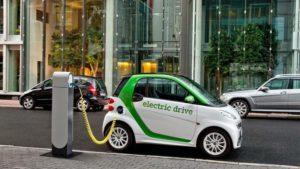 To quote a battery engineer: “For the European auto companies to change over to electric vehicles is like turning a battleship. And it’s a battleship with a mutinous crew.” As the European policy world noticed with this week’s French government surrender on diesel taxes, going green is not that easy. It will become even more difficult as EV production scales up. The problems are not only with public support for decarbonisation charges but with the increased burden on raw material supplies. Attention has already been drawn to how lithium ion batteries require cobalt, the biggest reserves of which are in the Democratic Republic of Congo. The DRC government knows how important cobalt has become, and in the past week has tripled its royalty charges on the mineral. The mining companies have protested, of course, but with their huge fixed costs and few alternative sources, they will pay up. The royalty increase, only the latest example of the DRC’s aggressive approach to increasing its take when prices go up, will tend to discourage new investment in large-scale mines in the country.
To quote a battery engineer: “For the European auto companies to change over to electric vehicles is like turning a battleship. And it’s a battleship with a mutinous crew.” As the European policy world noticed with this week’s French government surrender on diesel taxes, going green is not that easy. It will become even more difficult as EV production scales up. The problems are not only with public support for decarbonisation charges but with the increased burden on raw material supplies. Attention has already been drawn to how lithium ion batteries require cobalt, the biggest reserves of which are in the Democratic Republic of Congo. The DRC government knows how important cobalt has become, and in the past week has tripled its royalty charges on the mineral. The mining companies have protested, of course, but with their huge fixed costs and few alternative sources, they will pay up. The royalty increase, only the latest example of the DRC’s aggressive approach to increasing its take when prices go up, will tend to discourage new investment in large-scale mines in the country.
EV enthusiasts and manufacturers concerned about supply-chain audits have been working to reduce the cobalt content of batteries, with some success. However, Marc Grynberg, the chief executive of Umicore, the European battery component manufacturer (and cobalt buyer), suggests further progress will not be easy. For that matter, when policy people and the more optimistic auto manufacturers speak of reducing European dependence on the DRC and those cobalt-mining children, they have in mind increasing the proportion of nickel in EV batteries. Nickel is a problem. Most nickel we have used for the past century comes from high-grade nickel sulphide deposits. It is not technologically challenging to refine those ores to the high purity necessary for battery manufacturing.
Readily mined nickel sulphide deposits are being depleted, however, and over the next decade we will become dependent on the more common lateritic ore deposits. These are relatively easy to refine into low-purity grades, say for stainless-steel kitchenware. To make battery-grade nickel from lateritic ore, though, miners hope to use a tricky process called high pressure acid leaching (HPAL). If you do not do things just right, you have sulphuric acid under high pressure coming out of the machine. Try not to be around when that happens. A Russian nickel refining engineer refers to the HPAL manufacturing complex as “the Bermuda Triangle of death”. It would be better to take more time to develop the science of how batteries work. That would require years of work with sophisticated equipment, and the policy requirement is for a rapid switch from fossil fuel engines. In any event, Europe and the rest of the world will depend on diesel power for large trucks for the foreseeable future. The politics, the supply-chain difficulties and the requirement for better science all suggest that the European battery push is too frenetic to work well.
Source: “Going Green is not That Easy for Electric Vehicles”, Financial Times
